



Effects of Different Oil Sources and Vitamin E in Breeder Diet on Egg Quality, Hatchability and Development of the Neonatal Offspring
Addition of vitamin E (100 mg/kg of diet) played an effective antioxidant role in the egg yolk from hens fed fish oil, significantly reduced lipid peroxidation in the egg yolk, and promoted the development of the heart and liver of the progeny, according to S.Y. An of the China Agricultural University in Beijing, and co-authors.Abstract
Effects of polyunsaturated fatty acid (PUFA) and vitamin E (VE) supplementation in the diet of breeder hens on the egg quality and hatchability, lipid peroxides of the egg yolk, and development of the newly hatched offspring chicks were investigated.
A total of 800 Avian 48, 28-week-old broiler breeders were assigned randomly to four groups with four replicates of 45 females and five males.
Each group was fed one of the following four diets with different oil sources and levels of VE: corn oil (CO), fish oil (FO), CO+VE and FO+VE.
The results showed that:
- Addition of FO in the breeder diet reduced the whole egg weight, yolk weight, albumen weight, yolk colour score and neonatal offspring chick body weight without affecting the hatchability as compared to the CO treatment.
- Addition of VE efficiently reduced the lipid peroxides of egg yolk from hens fed diets containing FO.
- VE in the breeder diet significantly promoted the development of liver and heart of the chick offspring.
Introduction
It is known that breeder nutrition is one of the most important factors affecting quality of chick offspring, and may influence progeny growth, immunity and carcass attributes (Kidd, 2003). The nutrients required for chicken embryo development are derived from the nutrients stored in the egg, whose nutrient profile changes with the maternal diet (Cherian and Sim, 1997) and thereby creates differences in nutritional status of progeny (Ajuyah et al., 2003). From an economic analysis, Corzo and Kidd (2003) concluded that improving early chick viability via hen nutrition was profitable.
N-3 polyunsaturated fatty acid is receiving more attention in relation to food, nutritional and pharmaceutical applications because of its beneficial effects on cardiovascular health (Siddiqui et al., 2008), brain function and mental health (Gadoth, 2008), immunity (Wang et al., 2000) and inflammatory diseases (Kremer, 2000). Fish oil rich in n-3 PUFA plays different modulatory roles on immune function to corn oil, a source of n-6 PUFAs (He et al., 2007). N-3 PUFA often opposes the inflammatory effects of some n-6 PUFA (Darlington and Stone, 2001). The n-3 PUFA is highly susceptible to peroxidation (Oarada et al., 2008), especially in egg yolk which contains a lot of lipids. VE is the major fat-soluble antioxidant, which reduces lipid peroxidation and depresses oxidative stress (Guo et al., 2001; Sahin et al., 2006). Maternal supplementation of vitamin E has beneficial effects on antioxidant protection of the neonatal chick and postnatal development (Surai, 2000). There is little information about the impact of n-3 PUFA supplementation in the diet of breeder hens on egg quality, hatchability and the progeny.
The objective of the present study was to investigate the effects of two different oil sources (fish oil and corn oil) and vitamin E supplementation in the maternal diet on egg quality, hatchability, lipid peroxidation of the egg yolk, and development of neonatal chick offspring.
Materials and Methods
Birds and management
A total of 800 Avian 48, 28-week-old broiler breeders were randomly allocated to four groups with four replicates of 45 females and five males. The hens were housed in an environmentally controlled house with forced ventilation, cooling pads, an automatic water supply and 10-hole nest-box. The lighting programme was 16-hour light period every day. Management was conducted according to the recommended guideline from the company. The experiment lasted for eight weeks.
Experimental diets
The experimental diets are shown in Table 1. The two oil sources were corn oil (CO) and fish oil (FO, AV-8.8 mg KOH/g; POV-16 meqO2/kg), and dietary inclusion level was 2 per cent. The two levels of VE were 20 and 100 mg/kg. The four dietary treatments were as follows: CO+20 mg/kg VE, FO+20 mg/kg VE, CO+100 mg/kg VE and FO+100 mg/kg VE. The fatty acid profiles of different oils were analyzed by gas chromatography and are listed in Table 2. Daily feed allocation per female was based on production rate and body weight whereas for the male it was based on body weight according to the recommendations for primary breeders.
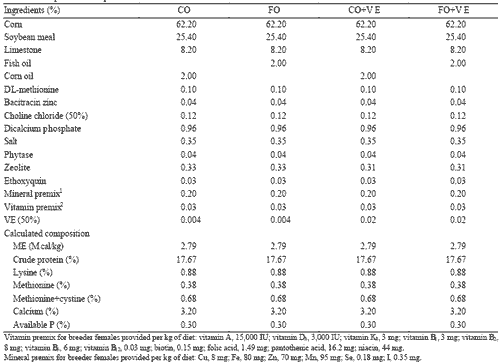
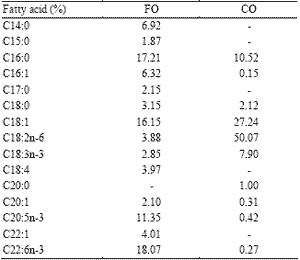
Sample collection and analysis
Egg quality: Eggs were collected daily and egg production was recorded and classified as settable, cracked, or abnormally shaped. Mortality was also recorded daily. For egg quality characteristics, 20 eggs per treatment were collected at the end of the 4th and 8th week of the experiment. The eggs were weighed, and yolks were separated using an egg separator and weighed. Albumen weight was calculated by subtracting yolk and shell weight from total egg weight. Egg shape index were determined by FHK (Fujihira Industry Co. Ltd., Tokyo, Japan). Eggshell breaking force was measured by egg shell Force Gauge (Model-II, Robotmation Co. Ltd., Tokyo, Japan). Eggshell thickness was measured in millimeters using Mitutoyo (Mitutoyo, 0-1'', Kawasaki, Japan). Eggshell colour was measured using an EQ Reflectometer (EQ Reflectometer, Technical Services and Supplies Co. Ltd., Tokyo, Japan). Albumen height, yolk colour and Haugh unit were measured automatically by egg multitester EMT-5200 (Robotmation, Co., Ltd., Tokyo, Japan).
MDA in egg yolk: Lipid peroxidation was expressed as malondialdehyde (MDA), and the concentration of thiobarbituric acid reactive substances (TBARS) was detected by biochemical methods following the instructions for reagent kits (Nanjing Jiancheng Bioengineering Institute, China).
Fertility, hatchability and newly-hatched body weight: At the end of the 6th week of the experiment, 2,304 eggs (144 per replicate) were collected randomly and incubated at 37.6°C and 61 per cent RH in a commercial incubator (EIXD2, QingDao, China) with automatic egg turning. These eggs were identified individually and placed in plastic trays, which were set randomly in the incubator. On day 19, these eggs were candled to determine fertility as the number of fertile eggs as a percentage of the total number of eggs set. Then the living embryos were transferred to a hatcher at 37.2°C, 79 per cent RH for the remaining incubation period. After 21 days incubation, the number and weight of live chicks were recorded to determine the hatchability and newly hatched body weight. Hatchability was calculated as the number of chicks hatched as a percentage of the number of fertile eggs. Newly-hatched body weight was represented by 10 birds from each of four replicate pens.
Development of the neonatal offspring: Forty-eight day-old chicks (three per replicate) were weighed and the yolk sac, heart and liver were separated and weighed to determine the development of the hatched chicks. The relative weight of yolk sac was expressed as a percentage of body weight, while the relative weight of heart or liver was expressed on the basis of the yolk sac-free chick weight.
Statistical analysis
Two-way analysis of variance was performed on all data using the General Linear Model (GLM) procedure of SPSS (SPSS 11.0), and Duncan's test was used to separate the means. A significance level was set at p<0.05.
Results and Discussion
Egg characteristics
At the end of the 4th week of the experiment (Table 3), the replacement of CO with FO reduced the weights of the eggs (p<0.05) and egg yolks (p<0.05). There was a significant interaction between oil source and VE level with respect to yolk weight, and the egg yolk weight was lowest for the FO group with VE 20 mg/kg.
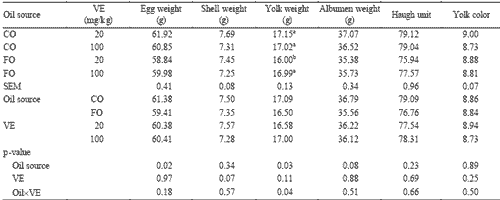
a, b Means within a row with no common superscript differ significantly (p<0.05)
At the end of the 8th week of the experiment (Table 4), the replacement of CO with FO significantly reduced the weights of the egg (p<0.01), egg yolk (p<0.01), egg albumen (p<0.01), and eggshell (p<0.01), and decreased the egg yolk colour (p<0.01); VE level of 100 mg/kg in the broiler breeder diet reduced egg weight (p<0.01), eggshell weight (p<0.05), albumen weight (p<0.01), and egg yolk colour score (p<0.05) compared with a VE level of 20 mg/kg.
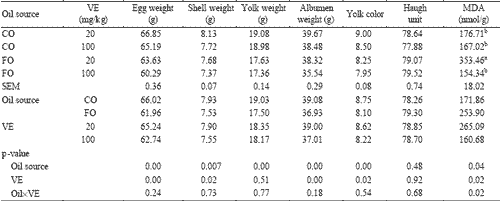
a, b Means within a row with no common superscript differ significantly (p<0.05)
There was no effect of dietary treatment on the egg shape index, eggshell thickness, eggshell breaking strength, eggshell pigment, albumen height (data not shown), and Haugh unit of the albumen.
In the present study, the effects of FO on the weight of eggs and its constituent parts were consistent with some previous reports (Whitehead et al., 1993; Nash et al., 1995; Pappas et al., 2005), but contrary to that of Basmacioglu and co-workers (2003).
The biochemical mechanism of the effect of dietary FO on the weights of eggs and its constituent parts might be related to energy metabolism. Dietary energy regulates the egg weight through influencing egg yolk weight (Wu et al., 2005), which is mediated by a mechanism of estrogen synthesis and metabolism. Diets rich in n-3 PUFA result in smaller yolks as a result of a reduction in plasma oestradiol (Whitehead et al., 1993). Lang and Davis (1990) found that an increased supply of PUFA interfered with the synthesis of very low-density lipoprotein (VLDL). VLDL is a precursor for egg yolk lipids. It has been reported that n-3 PUFA, like those found in FO, up-regulated the gene expression involved in fatty acid oxidation while simultaneously down-regulating genes involved in lipid synthesis (Clarke, 2001).
Yolk colour in FO treatment was decreased significantly (p<0.01) as compared to CO treatment at the end of the 8th week of the experiment (Table 4). The yolk colour is related to the content of xanthophylls (Scheideler et al., 1997) and addition of FO might exhaust the soluble antioxidant pigments, such as carotene and xanthophylls, which protect the lipids from oxidation. VE at 100 mg/kg in the broiler breeder diets also decreased the egg yolk colour (p<0.05) compared with VE at 20 mg/kg, suggesting that too much VE might disturb absorption of the pigment.
MDA content in egg yolk
MDA content in egg yolk was substantially increased due to the replacement of CO with FO in the broiler breeder diet at the end of the 8th week of the experiment (Table 4). VE at 100 mg/kg significantly decreased MDA concentration in egg yolk compared with VE at 20 mg/kg.
There was a substantial interaction (p<0.05) between oil sources and vitamin levels, the highest MDA was observed in egg yolk from breeder hens fed FO with VE at 20 mg/kg. These results were consistent with those of previous studies (Cherian et al., 1996; Surai, 2000).
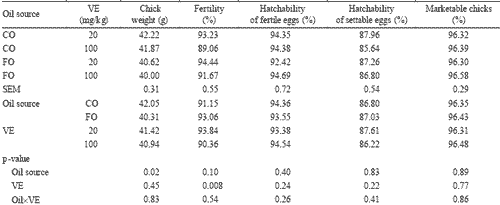
Fertility, hatchability and weight of newly-hatched chick offspring
Fertility was not influenced by PUFA (Table 5) but affected (p<0.01) by the VE level. VE at 20 mg/kg in hen diets increased fertility as compared to VE at 100 mg/kg, which did not agree with the results of Andi et al. (2006).
This may be related to the effect of high level of VE on egg quality. We know from the above discussion that addition of VE at 100 mg/kg in the broiler breeder diets significantly reduced egg weight, shell weight, albumen weight and egg yolk colour score compared with VE of 20 mg/kg at the end of 8th week of experiment, but the reasons need further study.
Hatchability of fertile eggs, hatchability of settable eggs and percentage of marketable chicks were not influenced by either oil source or VE level in breeder diets (Table 5). The effect of VE on hatchability in our study is consistent with a previous report (Andi et al., 2006). The finding is different from that of Pappas et al. (2006), who reported that hatchability was decreased by increased n-3 PUFA, and that FO inclusion in the breeder diet increased embryonic mortality during week 3 of incubation. The reasons for these differences were, firstly, FO level in the breeder diet of the present study (two per cent) was different to that of Pappas' study (65 g/kg); secondly, age of the breeders in this study (34 weeks old) was different to Pappas' study (23 and 27 weeks old); thirdly, the oil quality should not be neglected, because n-3 PUFA is prone to autoxidation, and oxidized oil is harmful to animals (Hung et al., 1981).
The neonatal chick weight was affected (p<0.05) by the oil source in the breeder hen diets (Table 5). The use of FO in the breeder diet resulted in lower weight of neonatal chicks as compared to the CO group. This agreed with the report by Pappas et al. (2006), who found that supplementation of FO in the maternal diet decreased the body mass of hatching chicks by almost 2g as compared to supplementation of soya oil. The results also indicated that high level of supplemental VE did not affect one-day-old chick weight.
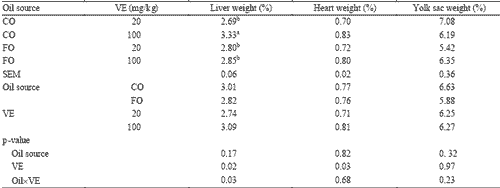
a, b Means within a row with no common superscript differ significantly (p<0.05)
The development of neonatal chick offspring
The relative heart and liver weights were enhanced significantly by higher level of VE supplementation (Table 6), and a significant interaction between oil sources and VE levels on liver weight was observed in the present study. The relative liver weight of chick progeny was the highest when hens were fed CO with 100 mg/kg VE. Dietary oil sources in breeder diets did not influence the relative weights of organs from the chick progeny at hatch.
The increased VE in yolk may prevent oxidative damage of the cells. Therefore VE at 100 mg/kg in breeder diets significantly promoted the development of liver and heart of the chick offspring. The rapid development of liver and heart was beneficial to reduce diseases such as ascites and helpful to improve subsequent growth performance.
Conclusion
N-3 PUFA-enriched FO inclusion in the breeder diet reduced egg weight and the weights of its constituents, simultaneously with increased lipid peroxidation in the egg yolk and a decrease in yolk colour, and subsequently reduced the hatching chick weight without affecting the hatchability compared with CO in the breeder hen diet. Addition of VE at 100 mg/kg of diet played an effective antioxidant role in the egg yolk from hens fed fish oil, significantly reduced lipid peroxidation in the egg yolk, and then promoted the development of heart and liver of the progeny.
Acknowledgements
This work was supported financially by the National Eleventh Five-Year Science & Technology Program of China (Project No. 2006BAD12B07).
References
Ajuyah, A.O., Y. Wang, H. Sunwoo, G. Cherian and J.S. Sim. 2003. Maternal diet with diverse omega-6/omega-3 ratio affects the brain docosahexaenoic acid content of growing chickens. Biol. Neonate 84(1):45-52. Andi, M.A., M. Shivazad, S.A. Pourbakhsh, M. Afshar, H. Rokni, N.E. Shiri, A. Mohammadi and Z. Salahi. 2006. Effects of vitamin E in broiler breeder diet on hatchability, egg quality and breeder and day old chick immunity. Pak. J. Biol. Sci. 9(5):789-794. Basmacioglu, H., M. Cabuk, K. Unal, K. Ozkan, S. Akkan and H. Yalcin. 2003. Effects of dietary fish oil and flax seed on cholesterol and fatty acid composition of egg yolk and blood parameters of laying hens. S. Afr. J. Anim. Sci. 33:266-273. Cherian, G., F.W. Wolfe and J.S. Sim. 1996. Dietary oils with added tocopherols. Effect on egg or tissue tocopherols, fatty acids, and oxidative stability. Poult. Sci. 75:423-431. Cherian, G. and J.S. Sim. 1997. Egg yolk polyunsaturated fatty acids and VE content alters the tocopherol status of hatched chicks. Poult. Sci. 76:1753-1759. Clarke, S.D. 2001. Polyunsaturated fatty acid regulation and gene transcription: a molecular mechanism to improve the metabolic syndrome. J. Nutr. 131:1129-1132. Corzo, A. and M.T. Kidd. 2003. Impact of parental nutrition on the progeny. World Poult. 19(10):40-50. Darlington, L.G. and T.W. Stone. 2001. Antioxidants and fatty acids in the amelioration of rheumatoid arthritis and related disorders. Br. J. Nutr. 85(3):251-269. Gadoth, N. 2008. On fish oil and omega-3 supplementation in children: The role of such supplementation on attention and cognitive dysfunction. Brain Dev. 30(5):309-312. Guo, Y., Q. Tang, J. Yuan and Z. Jiang. 2001. Effects of supplementation with Vitamin E on the performance and the tissue peroxidation of broiler chicks and the stability of thigh meat against oxidative deterioration. Anim. Feed Sci. Technol. 89:165-173. He, X., X.J. Yang and Y.M. Guo. 2007. Effects of different dietary oil sources on immune function in cyclophosphamide immunosuppressed chickens. Anim. Feed Sci. Technol. 139: 186-200. Hung, S.S.O., C.Y. Cho and S.J. Slinger. 1981. Effect of oxidized fish oil, DL-a-tocopheryl acetate and ethoxyquin supplementation on the VE nutrition of rainbow trout (salmo gairdneri) fed practical diets. J. Nutr. 111:648-657. Kidd, M.T. 2003. A treatise on chicken dam nutrition that impacts on progeny. J. World’s Poult. Sci. 59(4):475-494. Kremer, J.M. 2000. N-3 fatty acid supplements in rheumatoid arthritis. Am. J. Clin. Nutr. 71:349S-351S. Lang, C.A. and R.A. Davis. 1990. Fish oil fatty acids impair VLDL assembly and/or secretion by cultured rat hepatocytes. J. Lipid Res. 31:2079-2086. Nash, D.M ., R.M.G. Hamilton and H.W. Hulan. 1995. The effect of dietary herring meal on the omega-3-fatty-acid content of plasma and egg-yolk lipids of laying hens. Can. J. Anim. Sci. 75:247-253. Oarada, M., T. Tsuzuki, T. Gonoi, M. Igarashi, K. Kamei, T. Nikawa, K. Hirasaka, T. Ogawa, T. Miyazawa, K. Nakagawa and N. Kurita. 2008. Effects of dietary fish oil on lipid peroxidation and serum triacylglycerol levels in psychologically stressed mice. Nutrition 24:67-75. Pappas, A.C., T. Acamovic, N.H.C. Sparks, P.F. Surai and R.M. McDevitt. 2006. Effects of supplementing broiler breeder diets with organoselenium compounds and polyunsaturated fatty acids on hatchability. Poult. Sci. 85(9):1584-1593. Pappas, A. C., T. Acamovic, N.H.C. Sparks, P.F. Surai and R.M. McDevitt. 2005. Effects of supplementing broiler breeder diets with organic selenium and polyunsaturated fatty acid on egg quality during storage. Poult. Sci. 84(6):865-874. Sahin, N., K. Sahin, M. Onderci, M. Karatepe, M.O. Smith and O. Kucuk. 2006. Effects of dietary lycopene and vitamin E on egg production, antioxidant status and cholesterol levels in Japanese quail. Asian-Aust. J. Anim. Sci. 19:224-230. Scheideler, S.E., G. Froning and S. Cuppett. 1997. Studies of consumer acceptance of high omega-3 fatty acid-enriched eggs. J. Appl. Poult. Res. 6:137-146. Siddiqui, R.A., K.A. Harvey and G.P. Zalog. 2008. Modulation of enzymatic activities by n-3 polyunsaturated fatty acids to support cardiovascular health. J. Nutr. Biochem.19:417-437. Surai, P.F. 2000. Effect of selenium and VE content of the maternal diet on the antioxidant system of the yolk and the developing chick. Br. Poult. Sci. 41(2):235-243. Wang, Y.W., C.J. Field and J.S. Sim. 2000. Dietary polyunsaturated fatty acids alter lymphocytes unset proportion and proliferation, serum immunologlobulin G concentration, and immune tissue development in chicks. Poult. Sci. 79:174- 1748. Whitehead, C.C., A.S. Bowman and H.D. Griffin. 1993. Regulation of plasma oestrogens by dietary fats in the laying hen: Relationships with egg weight. Br. Poult. Sci. 34:999- 1010. Wu, G., M.M. Bryant, R.A. Voitle and D.A. Roland, Sr. 2005. Effect of dietary energy on performance and egg composition of Bovans White and Dekalb White hens during phase I. Poult. Sci. 84:1610-1615.Source
An S.Y., Y.M. Guo, S.D. Ma, J.M. Yuan and G.Z. Liu. 2010. Effects of different oil sources and vitamin E in breeder diet on egg quality, hatchability and development of the neonatal offspring. Asian-Aust. J. Anim. Sci. 23 (2): 234-239.
June 2010








